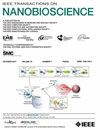CRISPR-Enabled Graphene-Based Bio-Cyber Interface Model for In Vivo Monitoring of Non-Invasive Therapeutic Processes
IF 3.7
4区 生物学
Q1 BIOCHEMICAL RESEARCH METHODS
引用次数: 0
Abstract
In this paper, we present a model of the bio-cyber interface for the Internet of Bio-Nano Things application. The proposed model is inspired by the gains of integrating the Clustered Regularly Interspace Short Palindromic Repeats (CRISPR) technology with the Graphene-Field effect transistor (GFET). The capabilities of the integrated system are harnessed to detect nucleic acids transcribed by another component of the bio-cyber interface, a bioreporter, on being exposed to the signalling molecule of interest. The proposed model offers a label-free real-time signal transduction with multi-symbol signalling capability. We model the entire operation of the interface as a set of simultaneous differential equations representing the process’s kinetics. The solution to the model is obtained using a numerical method. Numerical results show that the performance of the interface is influenced by parameters such as the concentrations of the input signalling molecules, the surface receptor on the bioreporter, and the CRISPR complex. The interface’s performance also depends considerably on the elimination rate of the signalling molecules from the body. For multi-symbol molecular signalling, the rate of degradation of the transcribed RNAs influences the system’s susceptibility to inter-symbol interference.基于石墨烯的 CRISPR 生物网络接口模型,用于体内监测非侵入性治疗过程。
在本文中,我们为生物纳米物联网应用提出了一个生物-网络接口模型。所提模型的灵感来自于将聚类正则间隔短联合重复序列(CRISPR)技术与石墨烯-场效应晶体管(GFET)集成的收益。利用该集成系统的能力,可以检测生物-细胞界面的另一个组件(生物报告器)在接触到相关信号分子时转录的核酸。所提出的模型提供了一种具有多符号信号能力的无标记实时信号转导。我们将界面的整个运行过程建模为一组表示过程动力学的同步微分方程。该模型的解是通过数值方法获得的。数值结果表明,界面的性能受输入信号分子浓度、生物报告器表面受体和 CRISPR 复合物等参数的影响。接口的性能还在很大程度上取决于体内信号分子的清除率。对于多符号分子信号,转录 RNA 的降解率会影响系统对符号间干扰的敏感性。
本文章由计算机程序翻译,如有差异,请以英文原文为准。
求助全文
约1分钟内获得全文
求助全文
来源期刊

IEEE Transactions on NanoBioscience
工程技术-纳米科技
CiteScore
7.00
自引率
5.10%
发文量
197
审稿时长
>12 weeks
期刊介绍:
The IEEE Transactions on NanoBioscience reports on original, innovative and interdisciplinary work on all aspects of molecular systems, cellular systems, and tissues (including molecular electronics). Topics covered in the journal focus on a broad spectrum of aspects, both on foundations and on applications. Specifically, methods and techniques, experimental aspects, design and implementation, instrumentation and laboratory equipment, clinical aspects, hardware and software data acquisition and analysis and computer based modelling are covered (based on traditional or high performance computing - parallel computers or computer networks).
 求助内容:
求助内容: 应助结果提醒方式:
应助结果提醒方式:


